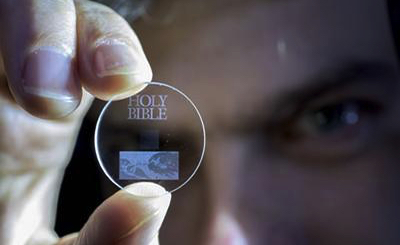5D Storage Capable of Surviving for Billions of Years – University of Southampton
360TB/disc using nanostructured glass with femtosecond laser writing
This is a Press Release edited by StorageNewsletter.com on March 1, 2016 at 2:32 pmScientists at the University of Southampton have made a major step forward in the development of digital storage that is capable of surviving for billions of years.
Using nano-0structured glass, scientists from the University’s Optoelectronics Research Centre (ORC) have developed the recording and retrieval processes of five dimensional (5D) digital data by femtosecond laser writing.
The storage allows unprecedented properties including 360TB/disc data capacity, thermal stability up to 1,000°C and virtually unlimited lifetime at room temperature (13.8 billion years at 190°C) opening a new era of eternal data archiving. As a very stable and safe form of portable memory, the technology could be highly useful for organisations with big archives, such as national archives, museums and libraries, to preserve their information and records.
The technology was first experimentally demonstrated in 2013 when a 300Kb digital copy of a text file was successfully recorded in 5D.
Now, major documents from human history such as Universal Declaration of Human Rights (UDHR), Newton’s Opticks, Magna Carta and Kings James Bible, have been saved as digital copies that could survive the human race. A copy of the UDHR encoded to 5D storage was recently presented to UNESCOen.unesco.org by the ORC at the International Year of Light (IYL) closing ceremony in Mexico.
Universal Declaration of Human Rights recorded into 5D optical data
The documents were recorded using ultrafast laser, producing extremely short and intense pulses of light. The file is written in three layers of nanostructured dots separated by five micrometres (one millionth of a metre).
The self-assembled nanostructures change the way light travels through glass, modifying polarisation of light that can then be read by combination of optical microscope and a polariser, similar to that found in Polaroid sunglasses.
Coined as the Superman memory crystal, as the glass memory has been compared to the memory crystals used in the Superman films, the data is recorded via self-assembled nano-structures created in fused quartz. The information encoding is realised in five dimensions: the size and orientation in addition to the three dimensional position of these nano-structures.
Professor Peter Kazansky, from the ORC, says: “It is thrilling to think that we have created the technology to preserve documents and information and store it in space for future generations. This technology can secure the last evidence of our civilisation: all we’ve learnt will not be forgotten.”
The researchers presented their research at the photonics industry’s SPIE – The International Society for Optical Engineering Conference in San Francisco, USA. The invited paper, 5D storage by Ultrafast Laser Writing in Glass as presented on 17 February.
The team are now looking for industry partners to further develop and commercialise this new technology.















 Subscribe to our free daily newsletter
Subscribe to our free daily newsletter


